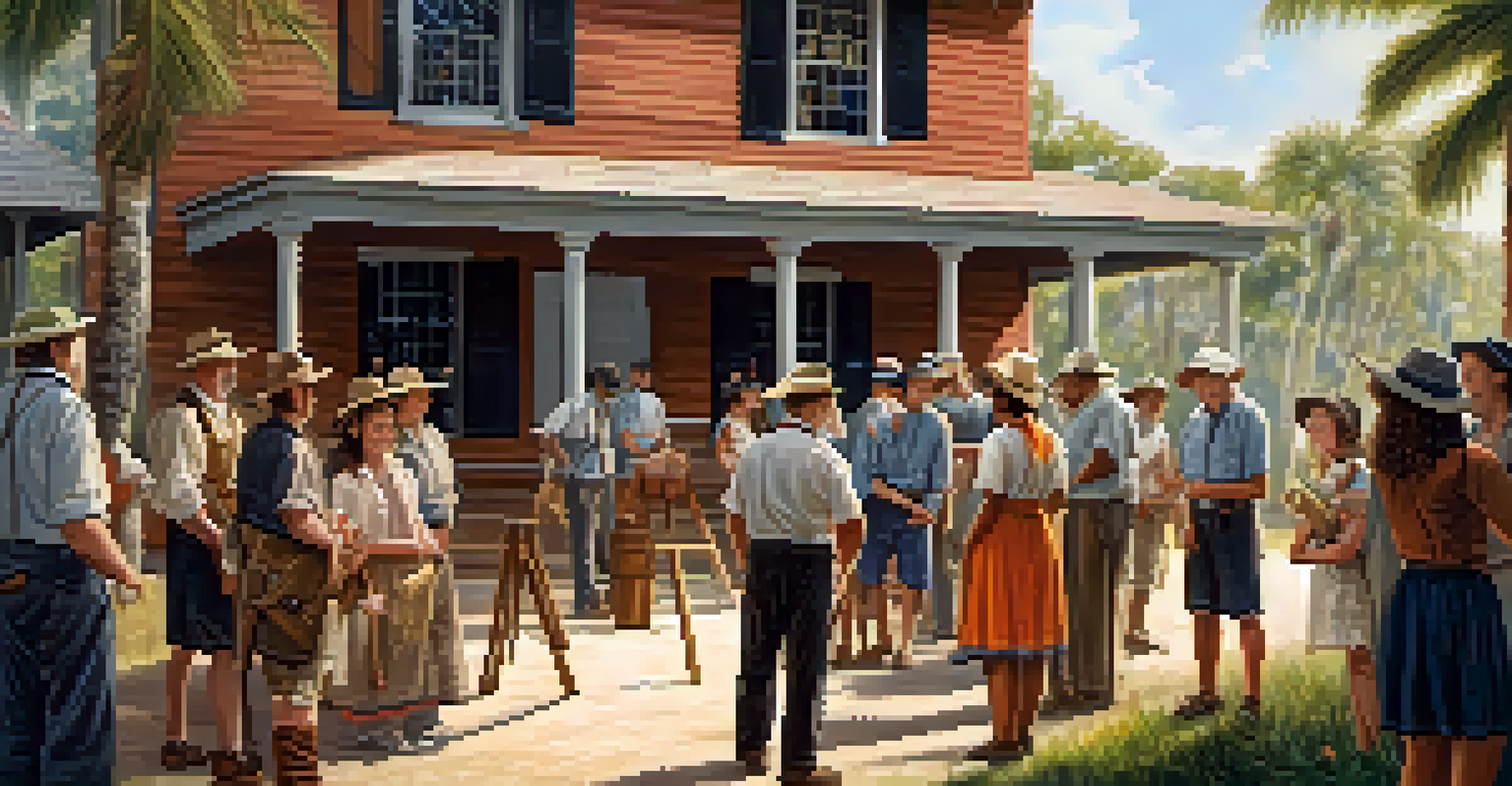The Impact of Tourism on Florida's Historic Preservation

Understanding Florida's Rich Historical Landscape
Florida is home to a diverse array of historical sites, from ancient Native American mounds to Spanish colonial forts. This rich tapestry of history is not just a backdrop; it shapes the state's identity and draws millions of visitors each year. Tourists flock to places like St. Augustine, the oldest city in the U.S., to experience its storied past firsthand.
Preservation is the foundation of our history and the key to our future.
These sites tell the stories of the people who shaped Florida, making them vital to understanding its evolution over the centuries. The preservation of these landmarks offers insight into the state's cultural heritage, attracting history buffs and casual visitors alike. In essence, these historic sites serve as living classrooms, bridging the past and present.
However, the influx of tourism places both opportunities and challenges on these sites. On one hand, increased foot traffic can lead to greater awareness and funding for preservation efforts. On the other hand, the wear and tear from visitors can threaten the integrity of these invaluable resources if not managed properly.
How Tourism Fuels Preservation Funding
Tourism generates significant revenue for Florida, which can be reinvested into preserving historic sites. Entrance fees, donations, and government grants often rely heavily on the traffic that tourism brings. For instance, many heritage sites increase their budgets through ticket sales, allowing them to fund restoration projects and educational programs.

In addition to financial support, tourism can raise awareness about the importance of conservation. When visitors engage with historical sites, they often leave with a deeper appreciation for preservation efforts. This heightened awareness can lead to increased advocacy and support for funding at both local and state levels.
Tourism Enhances Historical Preservation
Tourism generates vital revenue and awareness that supports the conservation of Florida's historic sites.
Furthermore, special events and festivals centered around historical themes can draw even larger crowds. These events not only celebrate Florida's history but also directly contribute to the financial health of preservation initiatives. It's a cycle where tourism and preservation mutually benefit each other, creating a sustainable model for the future.
The Role of Local Communities in Preservation
Local communities play a crucial role in maintaining and promoting Florida's historic sites. Residents often act as stewards of their local heritage, advocating for preservation initiatives and educating visitors. Their passion and knowledge help create a unique experience for tourists, fostering a sense of connection to the history.
History is not a burden on the memory but an illumination of the soul.
Community-led preservation efforts can enhance the authenticity of the visitor experience. For instance, local historians might conduct guided tours, sharing lesser-known stories that enrich the narrative of a site. This personal touch not only captivates tourists but also instills pride within the community.
Moreover, the involvement of locals can lead to sustainable tourism practices. By prioritizing preservation, communities ensure that tourism does not compromise their cultural and historical integrity. Instead, it becomes a way to celebrate and share their heritage with a broader audience.
Challenges of Balancing Tourism and Preservation
While tourism brings benefits, it also poses significant challenges to historic preservation. Increased visitor numbers can lead to overcrowding, which can degrade the very sites that tourists come to enjoy. For example, foot traffic can erode pathways and wear down structures, necessitating costly repairs.
Another challenge is the potential commercialization of historic sites, where the focus shifts from preservation to profit generation. This can result in the alteration of historical narratives to cater to tourist preferences, undermining the authenticity of the experience. The balance between generating income and maintaining historical integrity is delicate.
Community Involvement is Essential
Local residents play a crucial role in advocating for and maintaining the authenticity of historic sites.
To address these challenges, preservationists are implementing strategies like controlled access and visitor education programs. By managing how many people can access a site at once and teaching visitors about respectful behavior, they aim to protect these treasured locations. Striking the right balance is crucial for ensuring that Florida's rich history endures for future generations.
Innovative Preservation Techniques Driven by Tourism
As tourism evolves, so do the methods used for historic preservation. Technology plays a significant role in this evolution, with virtual tours and augmented reality experiences becoming increasingly popular. These innovations allow visitors to explore historic sites in new ways while minimizing physical wear and tear.
For instance, some sites offer interactive apps that guide tourists through historical narratives without needing to be on-site. This not only preserves the physical integrity of the location but also broadens access for those who may not be able to visit in person. Such technological advancements create a win-win scenario for both preservation and tourism.
Additionally, these innovations can attract a new demographic of tech-savvy tourists, which can further boost preservation funding. By appealing to younger audiences, historic sites can ensure their relevance in a rapidly changing world. Ultimately, embracing new technologies may help safeguard Florida's heritage for generations to come.
The Importance of Education in Preservation Efforts
Education is a cornerstone of both tourism and historic preservation. By informing visitors about the significance of historical sites, we foster a culture that values and respects our heritage. Educational programs, workshops, and guided tours enhance the visitor experience while instilling a sense of responsibility towards preservation.
Schools and local organizations often collaborate to create educational initiatives that engage both residents and tourists. These programs might include hands-on activities, lectures, or volunteer opportunities, allowing participants to connect with history on a deeper level. When people understand the stories behind the sites, they are more likely to support preservation efforts.
Balancing Tourism and Preservation
Managing visitor access and education is key to preventing overcrowding and preserving the integrity of historical landmarks.
Moreover, educated visitors are more likely to practice responsible tourism, ensuring they leave a minimal impact on the sites they visit. This collective effort can create a culture of preservation that benefits everyone. In Florida, education serves as a bridge between tourism and historic preservation, nurturing a shared commitment to safeguarding the past.
Looking Ahead: The Future of Tourism and Preservation in Florida
The future of tourism and historic preservation in Florida hinges on sustainable practices that respect both the environment and cultural heritage. As awareness of these issues grows, more organizations are prioritizing preservation in their tourism strategies. This shift indicates a promising outlook for the state’s historic sites.
Collaboration is key for ensuring that both tourists and preservationists achieve their goals. By working together, local governments, businesses, and communities can develop strategies that enhance the visitor experience while protecting historical integrity. These partnerships can lead to innovative solutions that benefit everyone involved.

Ultimately, the future will depend on the collective efforts of all stakeholders. With thoughtful planning and a shared commitment to preservation, Florida can continue to welcome visitors to its rich historical landscape while ensuring that its treasures remain intact for generations to come.